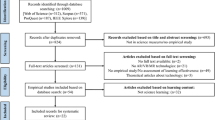Abstract
Augmented Virtuality (AV), the augmentation of a virtual environment with real-world objects or information, provides unique educational opportunities, such as photorealistic avatars (using content generation sensors) that convey natural gestures and body language, frames of reference for scale comparisons, and embodied cognition. In this research, we focus on the use of AV technologies for educational tours, such as nature walks, which are guided educational tours to teach students how to identify trees. Because additional content generation and tracking sensors require additional costs and logistics for educational deployment, we conducted a between-subjects experiment comparing AV systems with rear-only and front-and-rear Kinect sensor arrangements. While prior research indicates comparable tracking accuracies for such sensor conditions, we found significant differences between the two conditions. More importantly, we found evidence indicating that the rear-only sensor condition altered participant behavior and caused some participants to prioritize completing the educational tour quickly over correctly identifying trees and their features on the tour. However, we also found that both conditions afforded significant learning improvements, based on pre and post knowledge tests.





Similar content being viewed by others
References
Albert A, Hallowell MR, Kleiner B, Chen A, Golparvar-Fard M (2014) Enhancing construction hazard recognition with high-fidelity augmented virtuality. J Construct Eng Manag 140(7):04014024. https://doi.org/10.1061/(asce)co.1943-7862.0000860
Auvinet E, Multon F, Manning V, Meunier J, Cobb J (2017) Validity and sensitivity of the longitudinal asymmetry index to detect gait asymmetry using microsoft kinect data. Gait & Posture 51:162–168. https://doi.org/10.1016/j.gaitpost.2016.08.022
Borst CW, Lipari NG, Woodworth JW (2018) Teacher-guided educational VR: assessment of live and prerecorded teachers guiding virtual field trips. In: 2018 IEEE conference on virtual reality and 3D user interfaces (VR). https://doi.org/10.1109/vr.2018.8448286. IEEE
Brooke J (2013) Sus: a retrospective. J Usab Stud 8(2):29–40
Elmqaddem N (2019) Augmented reality and virtual reality in education myth or reality? International Journal of Emerging Technologies in Learning (iJET) 14(03):234. https://doi.org/10.3991/ijet.v14i03.9289https://doi.org/10.3991/ijet.v14i03.9289
Galloway C (2017) Blink and they’re gone: PR and the battle for attention. Public Relat Rev 43(5):969–977. https://doi.org/10.1016/j.pubrev.2017.06.010
Jones A, Swan JE, Singh G, Kolstad E (2008) The effects of virtual reality, augmented reality, and motion parallax on egocentric depth perception. In: 2008 IEEE virtual reality conference. https://doi.org/10.1109/vr.2008.4480794. IEEE
Kavanagh S, Luxton-Reilly A, Wuensche B, Plimmer B (2017) A systematic review of virtual reality in education. Themes Sci Technol Educ 10(2):85–119
Kennedy RS, Lane NE, Berbaum KS, Lilienthal MG (1993) Simulator sickness questionnaire: an enhanced method for quantifying simulator sickness. Int J Aviation Psychol 3(3):203–220. https://doi.org/10.1207/s15327108ijap0303_3
Kim J, Lee I, Kim J, LEE S (2015) Implementation of an omnidirectional human motion capture system using multiple kinect sensors. IEICE Trans Fund Electron Commun Comput Sci E98.A(9):2004–2008. https://doi.org/10.1587/transfun.e98.a.2004
Koppelman H, Vranken H (2008) Experiences with a synchronous virtual classroom in distance education. ACM SIGCSE Bull 40(3):194–198. https://doi.org/10.1145/1597849.1384324
Kumaravel BT, Anderson F, Fitzmaurice G, Hartmann B, Grossman T (2019) Loki. In: Proceedings of the 32nd annual ACM symposium on user interface software and technology. ACM. https://doi.org/10.1145/3332165.3347872
Kurillo G, Bajcsy R (2012) 3d teleimmersion for collaboration and interaction of geographically distributed users. Virt Real 17(1):29–43. https://doi.org/10.1007/s10055-012-0217-2
LaViola JJ Jr, Kruijff E, McMahan RP, Bowman D, Poupyrev IP (2017) 3d user interfaces: theory and practice addison-wesleyprofessional
Milgram P, Takemura H, Utsumi A, Kishino F (1995) Augmented reality: a class of displays on the reality-virtuality continuum. In: Das H (ed) Telemanipulator and Telepresence Technologies. https://doi.org/10.1117/12.197321. SPIE
Morato C, Kaipa KN, Zhao B, Gupta SK (2014) Toward safe human robot collaboration by using multiple kinects based real-time human tracking. J Comput Inform Sci Eng, 14(1). https://doi.org/10.1115/1.4025810https://doi.org/10.1115/1.4025810
Nilsson NC, Serafin S, Nordahl R (2016) Walking in place through virtual worlds. In: Lecture notes in computer science, pp 37–48. https://doi.org/10.1007/978-3-319-39516-6_4. Springer International Publishing
Raghuraman S (2017) i3DTI: Interactive 3D Tele-Immersion. PhD thesis
Regenbrecht H, Lum T, Kohler P, Ott C, Wagner M, Wilke W, Mueller E (2004) Using augmented virtuality for remote collaboration. Presence: Teleoperators and Virtual Environments 13(3):338–354. https://doi.org/10.1162/1054746041422334
Shin D-H (2017) The role of affordance in the experience of virtual reality learning: technological and affective affordances in virtual reality. Telematics Inform 34(8):1826–1836. https://doi.org/10.1016/j.tele.2017.05.013https://doi.org/10.1016/j.tele.2017.05.013
Vellingiri S, McMahan RP, Prabhakaran B (2020) Sceve: a component-based framework to author mixed reality tours. ACM Trans Multimed Comput Commun Applic (TOMM) 16(2):1–23
Vellingiri S, Prabhakaran B (2018) Quantifying group navigation experience in collaborative augmented virtuality tours. In: Proceedings of the 3rd international workshop on multimedia alternate realities. https://doi.org/10.1145/3268998.3269002. ACM
Vellingiri S, White-Swift J, Vania G, Dourty B, Okamoto S, Yamanaka N, Prabhakaran B (2020) Experience with a trans-pacific collaborative mixed reality plant walk. In: 2020 IEEE conference on virtual reality and 3d user interfaces abstracts and workshops (VRW). https://doi.org/10.1109/vrw50115.2020.00051https://doi.org/10.1109/vrw50115.2020.00051. IEEE
Wei T, Lee B, Qiao Y, Kitsikidis A, Dimitropoulos K, Grammalidis N (2015) Experimental study of skeleton tracking abilities from microsoft kinect non-frontal views. In: 2015 3DTV-conference: the true vision - capture, transmission and display of 3D video (3DTV-CON). https://doi.org/10.1109/3dtv.2015.7169367https://doi.org/10.1109/3dtv.2015.7169367. IEEE
Yukselturk E, Altıok S, Başer Z (2018) Using game-based learning with kinect technology in foreign language education course. J Educ Technol Soc 21 (3):159–173
Acknowledgements
This material is based upon work supported by the US Army Research Office (ARO) Grant W911NF-17-1-0299 and the National Science Foundation (NSF) under Grant No. 1626586. Any opinions, findings, and conclusions or recommendations expressed in this material are those of the author(s) and do not necessarily reflect the views of the ARO and NSF.
Author information
Authors and Affiliations
Corresponding author
Ethics declarations
Conflict of Interests
The authors declare that they have no conflict of interest.
Additional information
Publisher’s note
Springer Nature remains neutral with regard to jurisdictional claims in published maps and institutional affiliations.
Rights and permissions
About this article
Cite this article
Vellingiri, S., McMahan, R.P., Johnson, V. et al. An augmented virtuality system facilitating learning through nature walk. Multimed Tools Appl 82, 1553–1564 (2023). https://doi.org/10.1007/s11042-022-13379-w
Received:
Revised:
Accepted:
Published:
Issue Date:
DOI: https://doi.org/10.1007/s11042-022-13379-w




